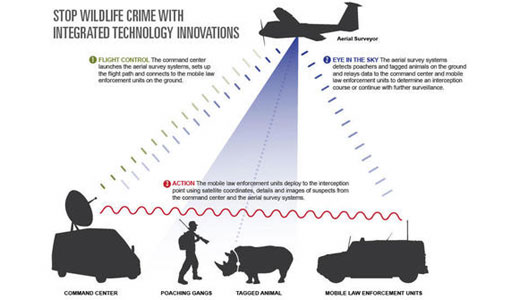
Both surveillance technology and Google have generated controversy – often, not without good reason – in the past. In opposition to the growing international threat of poaching, however, many feel they can be put to good use.
That theory will soon be tested: the World Wildlife Fund received a $5 million grant last week from Google’s Global Impact Awards to test advanced technology in the interest of combating crime against animals. If deemed effective, the spy tech will be implemented in environments including national parks plagued by poaching.
As Secretary of State Hillary Clinton pointed out at the Partnership Meeting on Wildlife Trafficking in November, poaching has become a high-tech criminal operation using helicopters, tactical gear, and high-powered rifles. Many believe the war on poaching is being lost because of these advancements, but conservation groups are taking a major leap forward and using some powerful tech of their own.
The new Google-funded system includes sensors that would be placed in wildlife habitats and on animals themselves, which would be monitored by networks of surveillance drones. The drones would signal ranger patrols when poachers are detected, hopefully allowing rangers to stop them.
Drones had previously been chosen to assist in the fight against poaching over the summer of this year, by the Nepalese chapter of the WWF, to be used in the country’s Chitwan National Park. The deployment of these aircraft marked the first time the organization had ever made such a bold move. Equipped with cameras and GPS, the remote-controlled observation drones were able to access and monitor hard-to-reach areas of the park, greatly benefiting conservation efforts.
As well, South Africa has used an aircraft of its own – though not a drone – to fight back against the illegal wildlife trade after several high-profile rhino killings in Kruger National Park. The reconnaissance plane was equipped with heat sensors that detected movement both animal and human.
Now, with the added benefit of Google funding, allowing for the use of more technology, the WWF will continue to make good use of aerial vehicles that are so often used for vile purposes, particularly overseas. Also important to know is that these drones are different than the armed government drones; these have been called little more than advanced, modified model airplanes.
“We believe that this technology will be instrumental … in curbing the illegal wildlife trade,” said Anil Manandhar, representative for WWF Nepal.
“We’ve seen a couple of other uses of technology to curb poaching,” wrote Popular Science, “notably the use of GPS tags on rhinos. But this time the WWF wants a larger umbrella of monitoring tech. [The technology] will be used in four separate sites in Asia and Africa, according to Google.”
“We want to use integrated technologies to create a protective umbrella around animals in poaching zones,” said Crawford Allan of TRAFFIC, the wildlife trade-monitoring network.
The Sea Shepherd Conservation Society, meanwhile, has deployed drones of its own in order to combat whaling in Japan. The two aerial vehicles typically remain on Sea Shepherd’s ships, the Steve Irwin and the Bob Barker, until they are needed, at which point they fly out and gather information.
Despite the controversy – most of it well deserved – surrounding drone technology, there is no doubt the vehicles are benefiting efforts to stop these illegal, anti-animal practices – Google’s reputation notwithstanding.
“We face an unprecedented poaching crisis,” said WWF president Carter Roberts. “The killings are way up, and we need solutions that are as sophisticated as the threats we face.”
Photo: A diagram depicting how the WWF’s new surveillance technology works in terms of combating poaching. World Wildlife Fund










